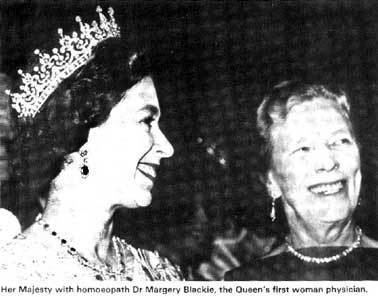Name Margery Blackie | ||
 | ||
Books Classical Homoeopathy, The patient, not the cure | ||
Margery Grace Blackie CVO (4 February 1898 – 24 August 1981) was a British doctor who later changed to homeopathy and became homeopath to Queen Elizabeth II.
Contents
Early life
Margery Grace Blackie was born at Redbourn, Hertfordshire, on 4 February 1898, the youngest of ten children of Robert Blackie (c.1852–1936), who was independently wealthy, and his wife, Elizabeth (d. 1941), daughter of Rowland Rees, the civil engineer and Mayor of Brighton. Her uncle, by marriage, was James Compton-Burnett, a noted Homeopathic Doctor. His daughter, the novelist Ivy Compton-Burnett was a first cousin. In 1911 the family moved to London, and she was educated at the Haberdashers' Aske's School for Girls in Acton. Her uncle Rowland Rees was an architect and politician in South Australia.
She studied medicine at the London School of Medicine for Women, and qualified as a doctor in 1923. In 1924, she joined the staff at the London Homeopathic Hospital. In 1928, she received her MD from the University of London, where she was the only woman candidate.
Career
In 1926, encouraged by her closest friend, Dr Helena Banks, she set up her own practice at Drayton Gardens, London, by reopening a homeopathic dispensary that had been closed for 12 years.
In 1929, together with Helena Banks, she moved to a practice in a large six-storey house at 18 Thurloe Square, South Kensington, London, where she was to remain until 1980, a year before her death. They were both ardent Christians, and for thirty years Banks was her "partner and intimate friend".
At the Royal London Homeopathic Hospital, Blackie was as assistant physician in the Children's Department from 1929 to 1937, an assistant physician from 1927 to 1957, and senior consultant physician from 1957 to 1966.
Blackie was the first homeopath to treat Queen Elizabeth II, from 1968 onwards. Other patients included Lady Julia Namier.
In 1978, it was reported that her medical bag for house calls at Buckingham Palace included "arsenic, strychnine, wormwood, wolfsbane, death cap mushroom, and the venom of the Gila monster, rattlesnake and hooded cobra", although in practice the principles of homeopathy suggest that her preparations would not have actually contained any of the substances they were named for.
Later life
In the last year of her life, from 1980 to 1981, she lived at Hedingham Castle with the owner, her close friend and companion, Miss Musette Frances Jacqueline Natalie Majendie CBE (1903–1981), the granddaughter of Lewis Majendie MP. On 24 August 1981, she died peacefully from a stroke, and was buried on 29 August at Castle Hedingham.
Personal life
Since 1945, she shared her London home with her close friend and secretary, Musette Majendie. They spent weekends at Hedingham Castle, the 100-acre estate which had been home to Majendie's family since 1720.
Publications
Honours
In 1979, she was appointed a Commander of the Royal Victorian Order, for her services to the royal family.
Legacy
The Blackie Foundation Trust is a charity that gives research grants and financial help to "medically qualified health care professionals". It was founded by Blackie in 1971, when she was homeopathic physician to the Queen.
In 1986, Constance Babington Smith published Champion of Homeopathy: the Life of Margery Blackie.
